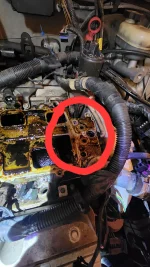The analogy is just that is hasn't failed in a visible way yet, but the clock is ticking.
Sometimes I try to be a nerd and go pretty deep into stuff like this, but I don't really know too much about the chemistry of how this stuff works. Because of that I mostly just report what I've seen, or the amount I do know to be true. Closest I've come to studying it is in an unrelated field, hydroponics. Trying to understand how plants change the pH of an electrically conductive nutrient solution based on uptaking or releasing hydroxide or hydronium ions, based on what nutrients they're uptaking.
I don't know if a solution can dissolve dissimilar metals in contact if it has a high ec or tds, (salt) but also is a base, like a pH of 11 or so. I honestly don't even understand how acid dissolves metal at all. It seems almost like magic to me!
I also don't know what is in, or could be in a coolant that can make rubber swell and melt.
I know that when you have 2 dissimilar metals in an electrically conductive solution, you have galvanic corrosion if they touch. Aluminum forms an oxide coating in air, (which is why you need ac balance on a tig welder to weld it) but that coating doesn't result in protection if it's in a solution that continuously dissolves it or causes it to form. Like road salt on an aluminum trailer with steel rivets, brackets, and bolts. The aluminum has to be separated from the steel with plastic or it turns to dust when the salt hits it. I've plasma cut out and welded in new floor on a few livestock trailers because part of the aluminum floor was in contact with the steel frame in the midwest winter road salt. I'm not saying dexcool, or the pre 2004 dexcool formula dissolves aluminum. However, I have wondered about that. I just pulled the 3.8 out of a car I bought for parts and when I pulled the upper coolant hose off the thermostat housing, the part of the housing the hose was on was covered in white dust, aluminum oxide. I thought that was actually pretty weird considering the hose being tightly clamped on it should have been blocking air, or oxygen, from reaching it. I have never seen that with a vehicle with green coolant. Now I'm debating pulling the lower
intake off and doing those gaskets because it did have dexcool in it. I don't want to have to do that later when the motor is already installed.
I also don't know why all these different coolant types exist. Why does a motorcycle use or specify a different coolant formula than a pickup, or a diesel engine? Don't they basically all have the same requirements? The wal mart coolant I've been buying says it's more or less compatible with everything. Probably not diesels though. Cummins/fleetguard makes an additive you pour into green coolant to make it meet their spec, if you don't want to buy the coolant from them. I have no idea what that is, but I remember it having all kinds of warning labels on it. Like this product will melt your whole face, be careful.




